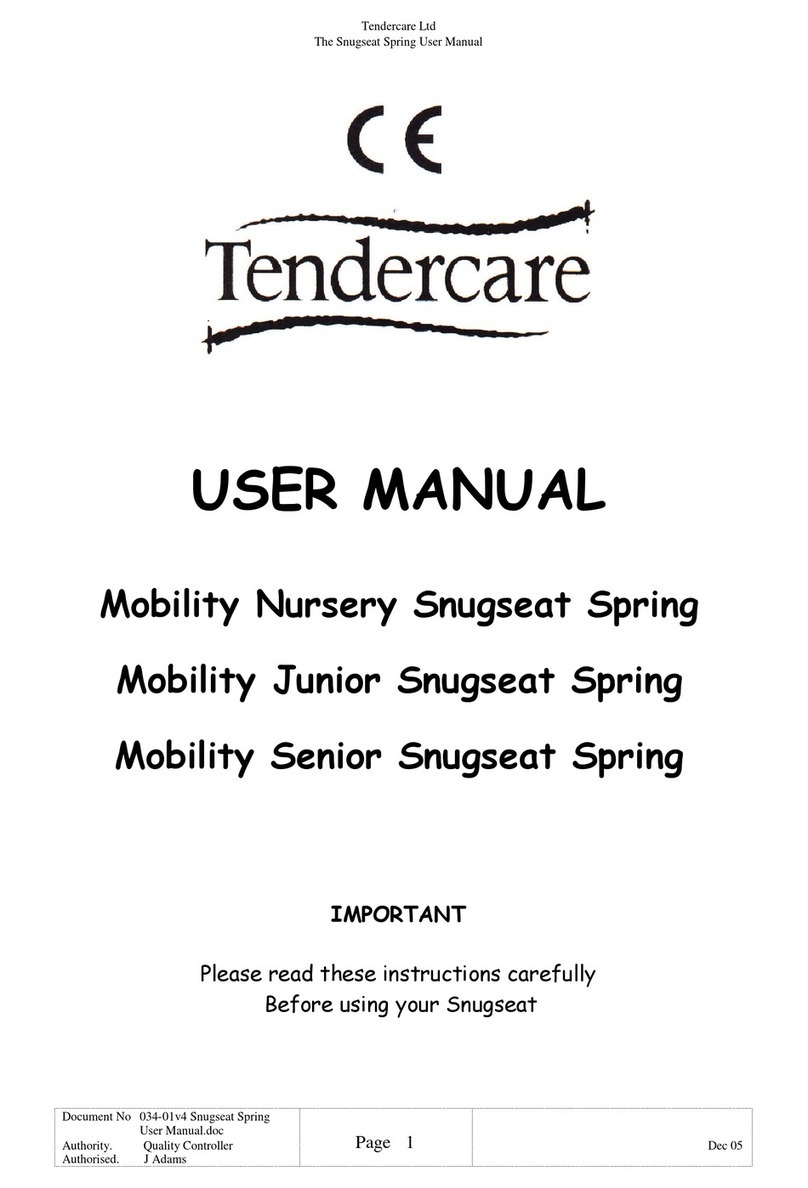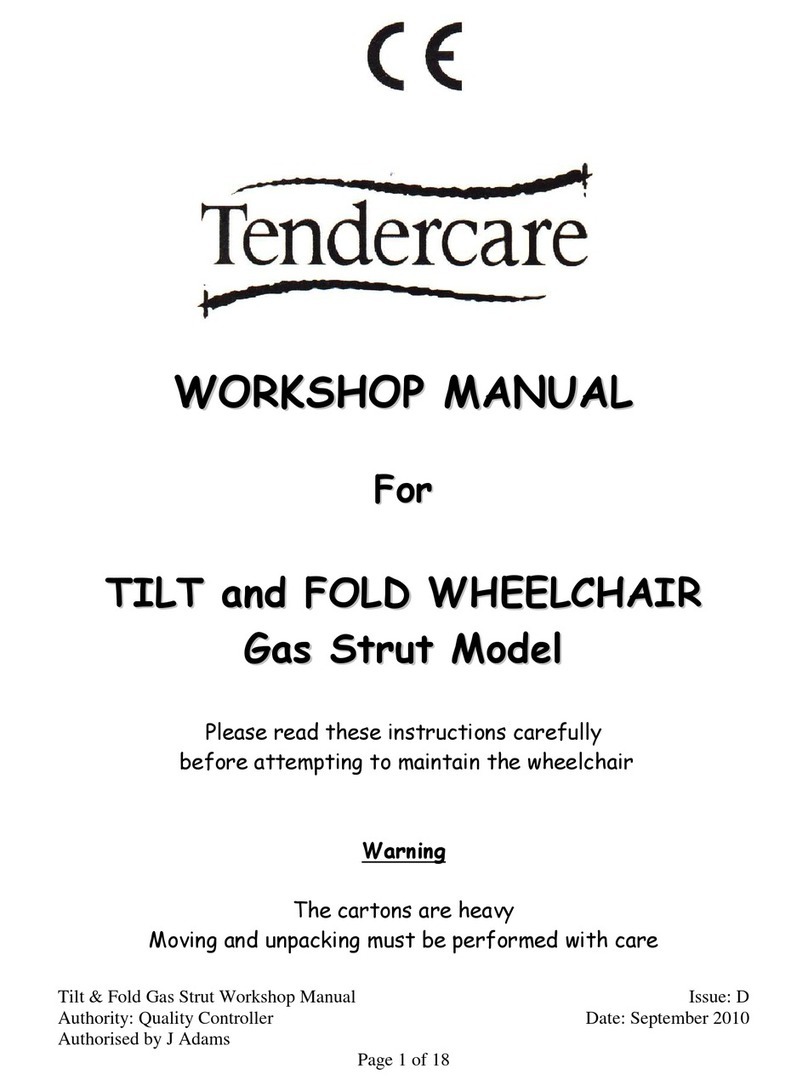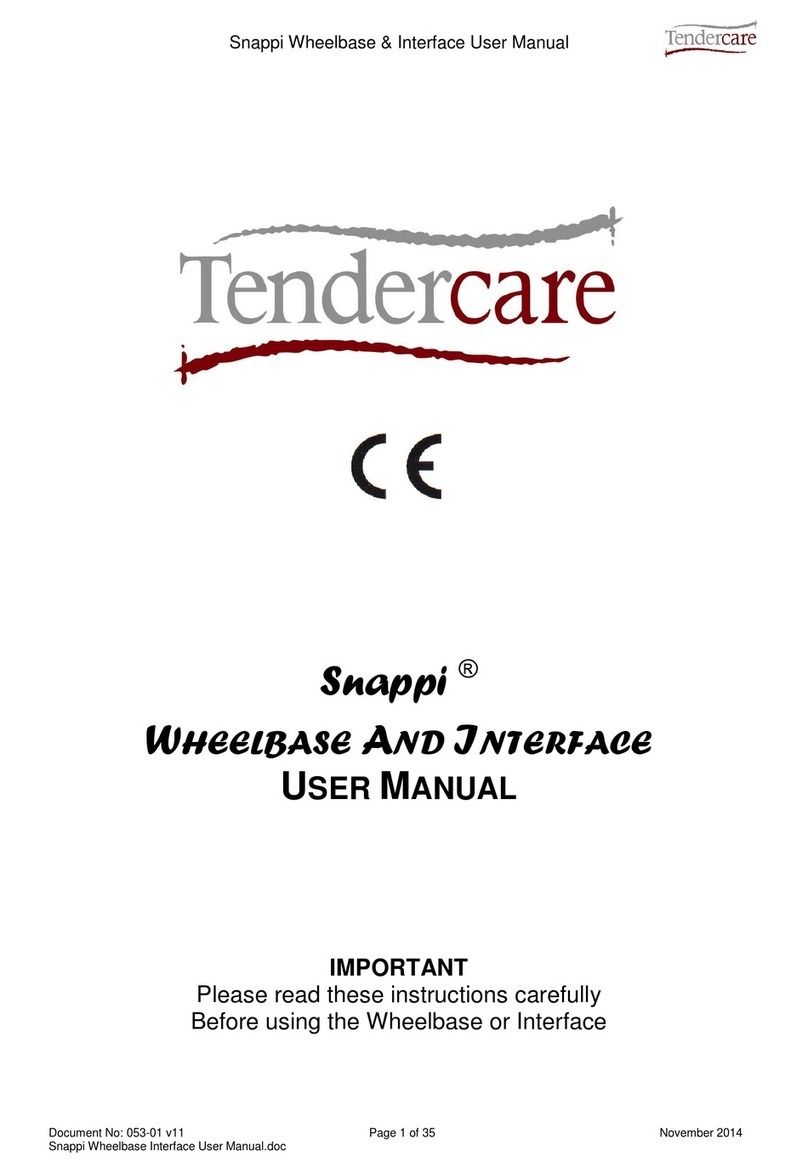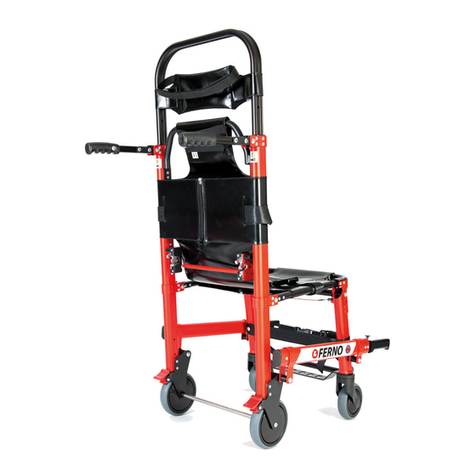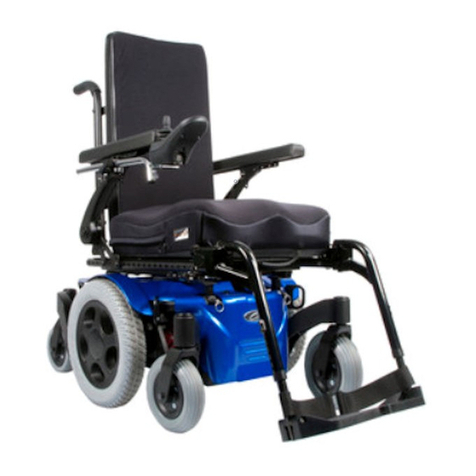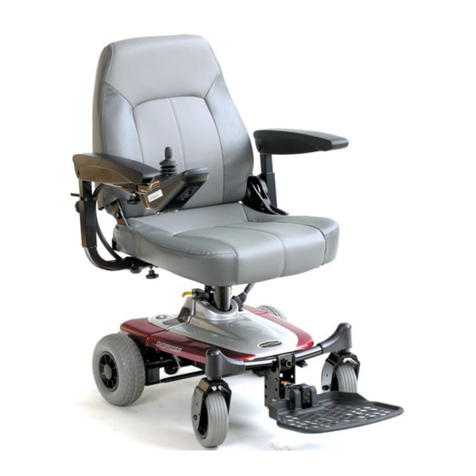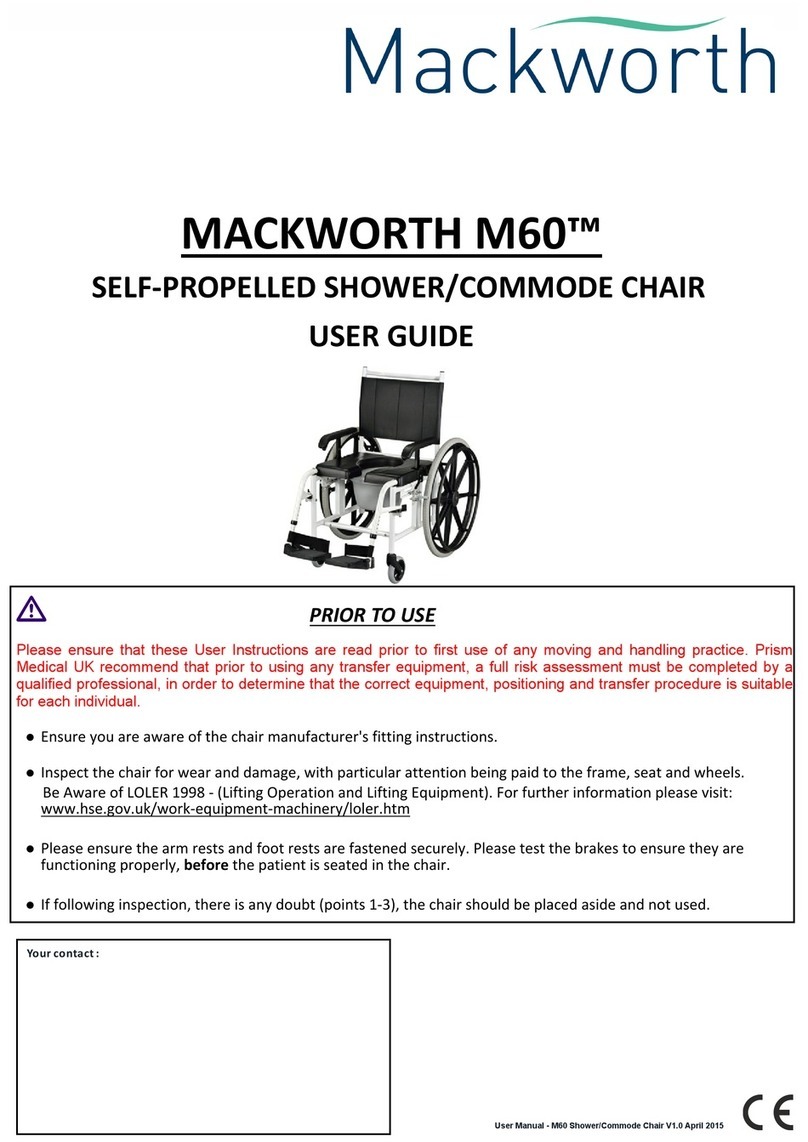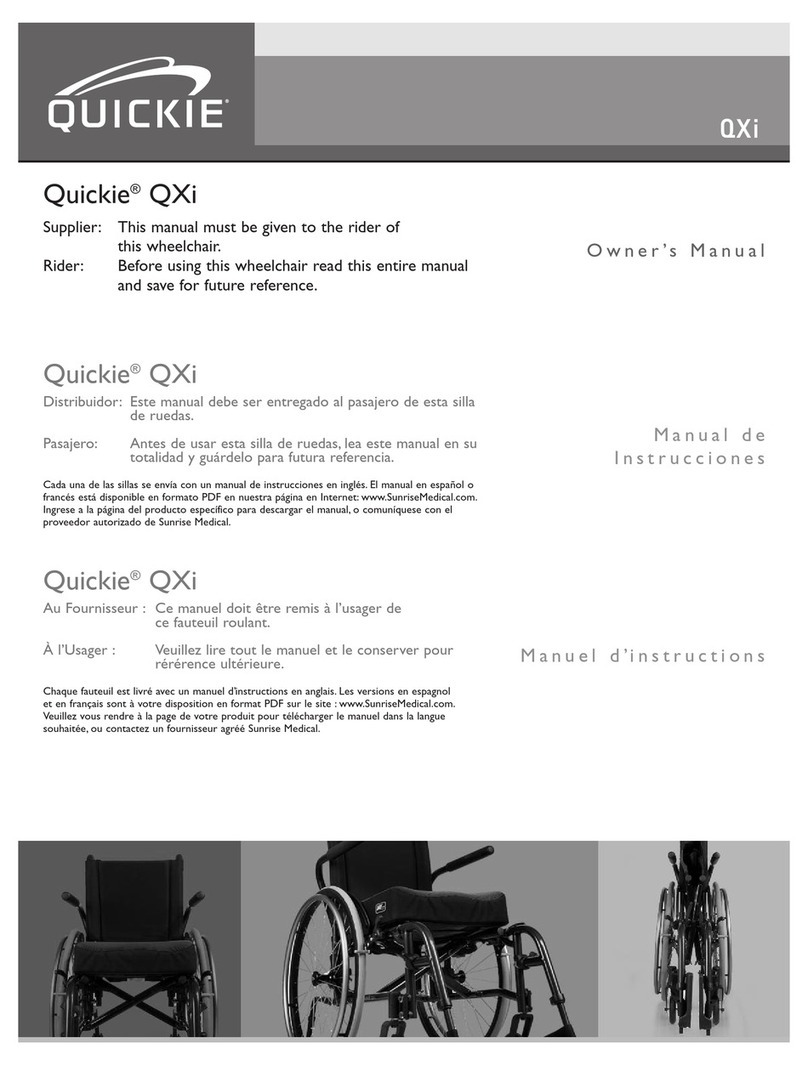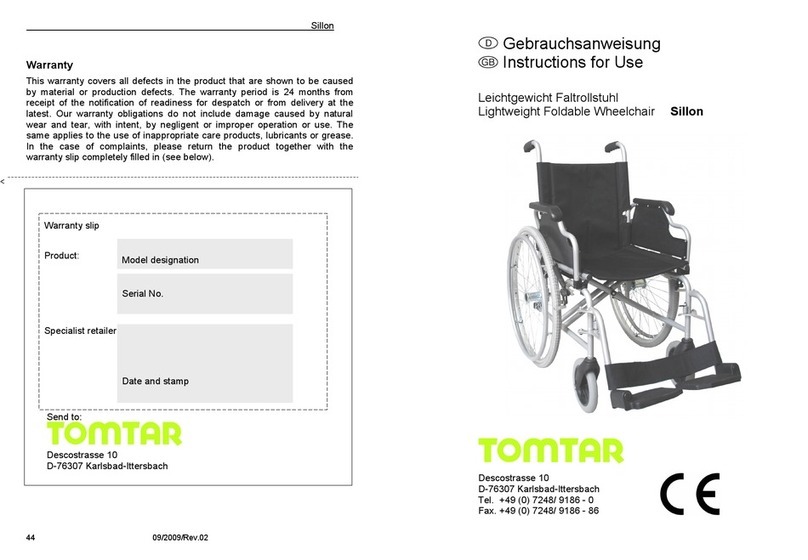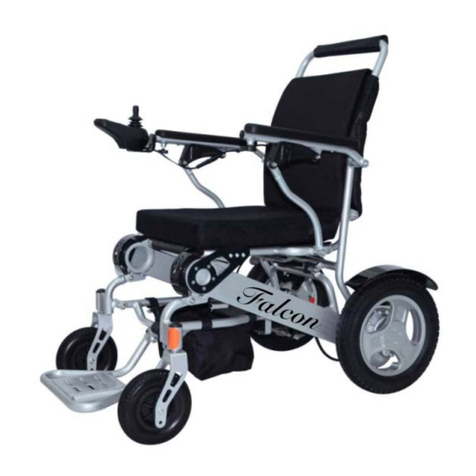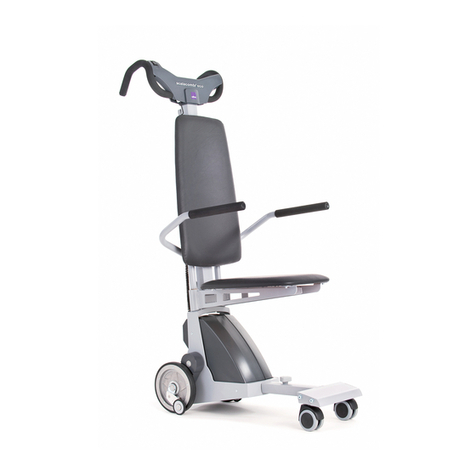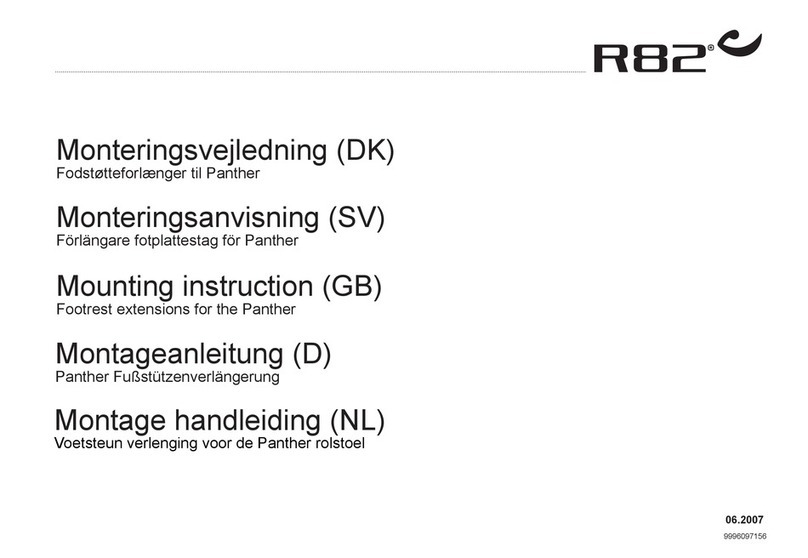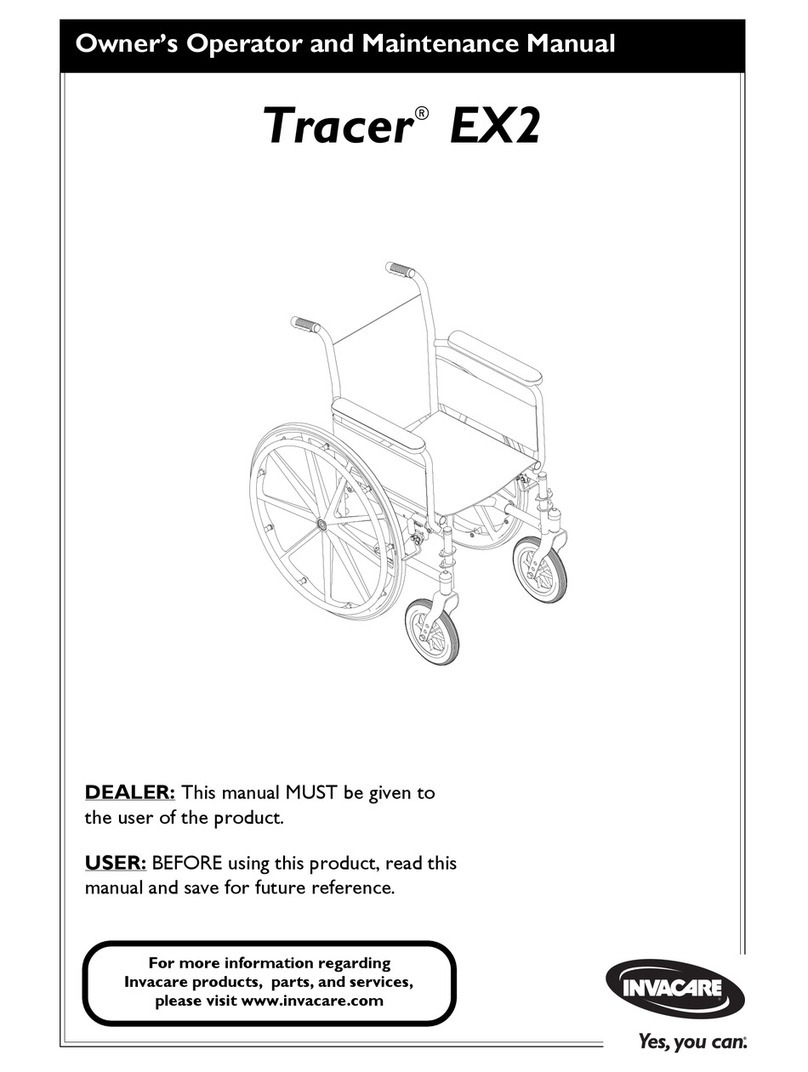Tendercare Mini Tilt Wheelchair User manual

Mini Tilt Wheelchair
Document No: 054-01 v6 Page 1 of 28 January 2014
Mintilt (newstyle) user manual.doc
Mini Tilt Wheelchair
User Manual
IMPORTANT
Please read these instructions carefully
Before using the Wheelbase or Interface

Mini Tilt Wheelchair
Document No: 054-01 v6 Page 2 of 28 January 2014
Mintilt (newstyle) user manual.doc
Fig 0.1: 14” Mini Tilt with standard accessories (partial tilt)
Fig 0.2: 14” Mini Tilt folded for transport
Half Height
Back Canvas
Armrest
Push
Handle
Tilt
Lever
Attendant
Brake
Handle
Clamping
Lever
Full Seat
Canvas
Backrest
Lock

Mini Tilt Wheelchair
Document No: 054-01 v6 Page 3 of 28 January 2014
Mintilt (newstyle) user manual.doc
Item
Description
Page
1 Who to contact in difficulty 4
2 Intended User 4
2.1 Size and weight 4 - 5
3 Unpacking 6
4 Preparing the wheelchair for use 6
4.1 Unfold and lock the backrest 7 - 8
4.2 Adjust the push handles 8 - 9
4.3 Fit and adjust the armrests 10
4.4 Footrests (optional) 10 - 11
4.5 Tilt in space 11
4.6 Tyres and brakes 12
4.7 Rear wheel position 12 – 13
4.8 Tipping the wheelchair 14
4.9 Accessories - Tay 14 - 16
5 User Instructions 16
5.1 Getting into the wheelchair 16
5.2 Getting out of the wheelchair 16
5.4 Sideways transfer 16
6 Attendant Pushing 17
6.1 Pushing 17
6.2 Brakes 17
6.3 Comfort 18
6.4 Lifting and general safety 18
7 Cleaning 18
8 Maintenance 19
8.1 Routine maintenance 19
8.2 Six-monthly maintenance 19
9 Warranty 20
10 Transport the wheelchair 20
10.1 Preparing the wheelchair for transport 20 – 22
10.2 Attaching wheelchair 23 – 25
11 Repairs 25

Mini Tilt Wheelchair
Document No: 054-01 v6 Page 4 of 28 January 2014
Mintilt (newstyle) user manual.doc
1: Who to contact in difficulty
Tendercare Ltd.
PO BOX 3091, Littlehampton, BN16 2WF
Tel: (01903) 726161 Fax: (01903) 734083
Email: [email protected]
Web: www.tendercareltd.com
2: Intended user
This product benefits from a tilt in space facility and has been designed for use as a
wheelchair or wheelbase for use with special seating systems. It is available in three seat
widths of 305mm (12”), 356mm (14”) and 406mm (16”). These instructions apply to all
sizes.
The wheelchair has 2 fixed rear wheels and 2 front castor wheels for easy steering. The
backrest can be folded for transit. The armrests lift off for easy side transfer and the push
handles are adjustable in height and angle to suit a wide range of attendants.
The maximum carrying weight is to include occupant, seating systems and all accessories
and should not exceed 57Kg (9 stone).
2.1: Size and weight:
All sizes and weights are given as a guide. Tendercare ltd reserves the right to amend
specifications at any time as part of their product development programme.
Weight*:
12”: 16 kg
14”: 16.8 kg
16”: 17.6 kg
*Weight includes complete frame and the following standard accessories: Armrests, half
height canvas set, attendant brakes and push handles.
The occupant’s safety is your responsibility. As such we recommend that you read
the complete user manual prior to using your wheelchair.

Mini Tilt Wheelchair
Document No: 054-01 v6 Page 5 of 28 January 2014
Mintilt (newstyle) user manual.doc
Dimensions (mm)
Mini Tilt Open (no tilt)
12” 14” 16”
A 670 670 715
B 500 550 565
C 1050 1050 1050
Dimensions (mm)
Mini Tilt Folded
12” 14” 16”
A 860 860 860
B 500 550 565
C 590 590 590

Mini Tilt Wheelchair
Document No: 054-01 v6 Page 6 of 28 January 2014
Mintilt (newstyle) user manual.doc
3: Unpacking
The wheelchair is delivered in a cardboard carton approximate weight 20 kg and size
630mm wide x 595mm deep x 890mm high.
Warning the transit carton is heavy so moving and unpacking must be done with
care. Observe all lifting and handling regulations.
1. Stand the carton upright making sure it is supported and cannot fall over. Open the
carton and remove any packages or packing, which could obstruct the removal of
the frame.
2. Carefully pull out the wheelchair and check that you have the following items:
Item Component QTY. Yes No
1 Mini Tilt Wheelchair 1
2 Armrests 2
3 User Manual 1
IMPORTANT:
If any items are damaged or missing, then please contact Tendercare, preferably by
within 36 hours of delivery.
After unpacking and checking you have all components and they are in good condition
dispose of the packaging at your local recycling centre. Alternatively retain and reuse.
4: Preparing the wheelchair for use
Warning: When assembling the wheelchair for use, ensure that you hold the frame
so that you avoid any danger of catching your fingers in moving parts.
Keep children clear of the wheelbase during opening and folding.

Mini Tilt Wheelchair
Document No: 054-01 v6 Page 7 of 28 January 2014
Mintilt (newstyle) user manual.doc
4.1: Unfold and lock the backrest:
Fig 4.1.1
The Mini Tilt will be supplied complete, but
in its folded position.
First unfold the back by lifting the backrest
as far as it will move (see left).
Please note that the locking bolts must be in
the “unlocked” position as shown, if they are
extended into the “locked” position it will not
be possible to move the back into its full
upright position.
There are 2 bolts located either side of the
backrest near the hinge.
With the back is in its full upright position,
lock the bolts by moving the black ball knob
towards the outside of the chair so it moves
out of its docking position.
The bolt is spring-loaded and will drop down
into the receiver tube in the frame.
Fig 4.1.2
Fig 4.1.3
Always ensure that the bolts have moved
the full length of the slot, and cannot move
any further.
To release the locking bolts, lift the full
length of the slot and move towards the
inside of the chair.
This will restore them to the unlocked
position and allow the backrest to be folded
for transport.
Note: Always support the backrest when
folding to avoid it dropping down too
quickly. We recommend holding the
backrest by the rear crossbar when
folding.

Mini Tilt Wheelchair
Document No: 054-01 v6 Page 8 of 28 January 2014
Mintilt (newstyle) user manual.doc
4.2: Adjust the push handles:
The Mini Tilt has clamp locking push
handles that can be adjusted in height, and
also rotated to any angle as needed.
To adjust the handle, first loosen the
clamping lever by rotating it anti-clockwise
as shown.
Fig 4.2.1
Fig 4.2.2
Once loose, simply move the handle to the
required height and angle, and lock by
rotating the clamping lever in the opposite
direction until the handle no longer moves.
The push handles have a safety
mechanism, which prevents the handle from
being fully removed from the frame.
IMPORTANT:
Always ensure that the push handles are
firmly locked before using the
wheelchair.

Mini Tilt Wheelchair
Document No: 054-01 v6 Page 9 of 28 January 2014
Mintilt (newstyle) user manual.doc
It is also possible to adjust the position of
the lever arm without releasing the handle.
To do this, place your thumb or a finger on
the red button, and pull back on the lever.
Then simply rotate the lever arm to the
desired position and release.
The lever is spring-loaded and will snap
back into its normal working position.
IMPORTANT: Do not attempt to hang
anything on the clamping lever. The
leaver is not intended to carry load and
doing so may break the lever.
Fig 4.2.3
4.3: Fit and adjust the armrests:
Fig 4.3.1
To fit the armrest, loosen thumbscrew A
(turn anti clockwise) and release the spring
catch B by turning 90 degrees in either
direction. Whilst holding catch B in this
position, push the armrest into the socket.
Ensure that the holes on the armrest stem
are facing catch B.
To lock: Release catch B when the armrest
is at the desired height, and tighten
thumbscrew A to secure.
To adjust the height, loosen the thumbscrew
and release catch B, adjust the height and
lock as described above.
TIP: When folding the wheelchair for transport, always remove the armrest first, and then
fold the back.

Mini Tilt Wheelchair
Document No: 054-01 v6 Page 10 of 28 January 2014
Mintilt (newstyle) user manual.doc
4.4: Footrests (optional):
The footrests are fitted to the wheelchair when it is supplied (if ordered). They can be
moved forward and back, up and down. The footplate can be lifted to the vertical position
for easy transfers in and out of the wheelchair.
To adjust the footrest depth:
Loosen thumbscrew ‘C’ (see right), until the
footrest stem is free to move.
Move the footrest stem to the desired
location, then re tighten the thumbscrew.
Fig 4.4.1
Fig 4.4.2
To adjust the footrest height:
Using a 5mm hexagon key loosen the screw
on the side of the footrest (see left).
Move the footrest to the desired height and
retighten the screw.
IMPORTANT: Make sure the screw fits
into one of the indentations in the
support rod.
Lifting the footplate: The footplates can be lifted into the vertical position for easier
transfers in and out of the wheelchair. To do this, simply hold the inside edge of the
footplate and lift up.
Thumbscre
w
C

Mini Tilt Wheelchair
Document No: 054-01 v6 Page 11 of 28 January 2014
Mintilt (newstyle) user manual.doc
4.5 Tilt in Space:
The angle of the seat and backrest can be adjusted to any angle between upright and fully
reclined.
To recline the seat, put the brakes on and
stand behind the wheelchair. Holding both
push handles squeeze the ‘tilt lever’ (see
right) and push down evenly on both
handles. Release the lever when the seat is
at the required angle.
To bring the seat upright, put the brakes on
and stand behind the wheelchair. Holding
both push handles squeeze the tilt lever and
lift evenly with both hands. Release the
lever when the seat is at the required angle.
Fig 4.5.1
Important: Always put the brakes on and move both push handles together when
adjust the seat angle.

Mini Tilt Wheelchair
Document No: 054-01 v6 Page 12 of 28 January 2014
Mintilt (newstyle) user manual.doc
4.6 Tyres and brakes:
The tyres are made from a solid material and do not require any attention other than being
cleaned with a damp cloth when dirty.
Mini Tilt Wheelchairs supplied before 16
th
of June 2010 were fitted with a screw fixing
brake system. Wheelchairs supplied after this date are fitted with a clamp mounting brake.
Screw fixing brake (old style) instructions:
Fig 6.4.1
Check the brakes by moving both levers
(“D” see fig 4.6.1, left) forward as far as
they will go. The wheels should now be
locked. If the wheels move the brakes need
adjusting.
To adjust the brake, loosen the nut on
adjustment screw ‘E’ (see left). Rotate the
brake block and unscrew it until it is close
to, but not touching, the tyre in the
“unlocked” position. Re-tighten the locking
nut.
Always adjust both brakes at the same time
and recheck the brakes after adjusting.
Note: Do not leave the brakes ON for a
long period. If you do, a flat section may
appear on the tyre. When not using the
wheelchair i.e. overnight or during storage,
always make sure the brakes are OFF.
Clamp fixing brake (new style) instructions:
Check both brakes by moving lever “F” (see
fig 4.6.2) forwards as far as it will go. The
wheels should now be locked.
If the wheels move the brakes need
adjusting. To adjust the brake, loosen the
two screws “G” (see fig 4.6.3) one turn only,
and then slide part “H” (see fig 4.6.3)
backwards towards the wheel.
Always adjust both brakes at the same time
and recheck the brakes after adjusting.
Fig 4.6.2
F

Mini Tilt Wheelchair
Document No: 054-01 v6 Page 13 of 28 January 2014
Mintilt (newstyle) user manual.doc
Fig 4.6.3
If the wheelchair is fitted with (optional) Hub
Brake wheels the standard Occupant brake
will also be fitted. Hub brakes are for the
attendants use only and not for use as a
parking brake. You must ensure that the
supplied Occupant parking brakes are used
when the chair needs to be parked and you
must not rely on any parking brake which
may be fitted to the Hub Brakes.
Note: Do not leave the brakes ON for a
long period. If you do, a flat section may
appear on the tyre. When not using the
wheelchair i.e. overnight or during storage,
always make sure the brakes are OFF.
Do not leave the wheelchair on a slope, even with the brake on. Always ensure that
the wheelchair is on level ground to prevent risk of injury to the occupant.
4.7 Rear wheel position:
The rear wheels are supplied mounted in the forward position to provide optimum ease of
manoeuvring and tipping. However, a small number of people may require a greater
degree of stability. If this is the case the rear wheels and brakes can be moved to the rear
mounting position. Only someone who is a competent tradesman or repairer should carry
out this procedure.
To move the rear wheel position:
Using two 19mm spanners undo the axle-
mounting nut. Make sure you note the
position of the washer and spacer bushing.
Reassemble in the rear position, apply
loctite to the threads and tighten the nut.
Fig 4.7.1
Once the rear wheel has been moved, the brake needs to be re-positioned.
G
H

Mini Tilt Wheelchair
Document No: 054-01 v6 Page 14 of 28 January 2014
Mintilt (newstyle) user manual.doc
Moving the screw fixing (old style) brake:
Fig 4.7.2
To move the brake assembly, use a 3mm
hexagon key and 8mm spanner to remove
the rear brake linkage screw making a note
of the position of the spacers (see below)
Fig 4.7.3
Using a 4mm hexagon key and 10mm spanner, remove the two back plate retaining
screws, tube support bushings and brake spacer taking note of the position of the locknut
and washers. Remove the caps from the 3
rd
mounting hole using a small flat bladed
screwdriver, then refit the screws making sure that the tube support bushing is placed
through the tube, and the brake spacer is correctly positioned (see photos below).
Fig 4.7.4
Fig 4.7.5
Once complete, refit the caps into the open hole
(these simply push into place), and reassemble
the rear brake linkage.
Finally adjust the brakes as described in section
4.6.
Moving the clamp fixing (new style) brake:
To move the clamp fixing brake, loosen the 2 x nuts ‘G’ (see Fig 4.6.3, above), then slide
the entire brake assembly along the rear frame tube until the brake block is sitting close to
the rear tyre in the unlocked position. Tighten the 2 x nuts ‘G’ and test the brake. If
necessary adjust the brake position to ensure it locks securely.

Mini Tilt Wheelchair
Document No: 054-01 v6 Page 15 of 28 January 2014
Mintilt (newstyle) user manual.doc
4.8: Tipping the wheelchair
To tip the wheelchair backwards when
climbing kerbs, stand behind the wheelchair
holding onto both push handles. Place one
foot; either right of left whichever suits you,
onto the tipping point (see right). Press
down with your foot and pull back with your
arms. The front of the chair will lift.
Fig 4.8.1
Important:
Take great care when tipping to avoid the combined weight of occupant and
wheelchair overcoming your strength and tipping backwards onto you. Never try to
tip the wheelchair if the occupant is heavier than you are.
4.9: Accessories - Tray
The tray offers height, depth and angle
adjustment, so that it can be adapted to suit
your needs.
There are several styles of tray available
(e.g. transparent, black, grey etc), the
transparent style tray has been used for
illustration purposes.
The tray comes supplied with the following:
•2 fixed vertical stems (fitted to the
tray)
•2 depth adjustment brackets and
thumbscrews (fitted to the tray)
•2 Angle adjustable receivers and
thumbscrews (fitted to the armrests
of the Mini Tilt)
Fig 4.9.1
Tipping Point

Mini Tilt Wheelchair
Document No: 054-01 v6 Page 16 of 28 January 2014
Mintilt (newstyle) user manual.doc
Fig 4.9.2
To fit the tray to the seat, locate the 2
vertical stems on the bottom of the tray into
the 2 receivers on the armrests.
Position the tray to the required height, and
then secure it in place by tightening the
thumbscrews (‘A’ see left).
To adjust the angle of the tray, loosen the 2
angle adjustor screws ‘B’ (see right), using a
5mm hexagon key (not supplied).
Adjust the angle as required, and then lock
in place by retightening the adjuster screws.
Fig 4.9.3
Fig 4.9.4
To adjust the depth of the tray, loosen the 2
thumbscrews under the base of the tray
(see left).
Slide the tray in or out to the required depth,
and then retighten the screws.

Mini Tilt Wheelchair
Document No: 054-01 v6 Page 17 of 28 January 2014
Mintilt (newstyle) user manual.doc
Notes:
•The tray must be removed when transporting the chair in specially adapted
vehicles.
•The tray and armrests must be removed before folding the wheelchair.
•Never leave the occupant unattended with the tray fitted, especially when items are
positioned on the tray.
•Extra care must be taken when placing food or drink on the tray.
•When operating the Tilt In Space facility, items must be removed from the tray to
ensure they do not cause accidental harm to the occupant. The angle of the tray will
need to be adjusted to allow for a new horizontal position (see above instructions
for how to adjust the angle of the tray).
•Maximum carrying capacity of the tray is 5kg.
5: User Instructions
5.1: Getting into the wheelchair
1. Put the brakes on.
2. Lift the footplates
3. Lower yourself onto the seat using the armrests for support.
4. Lower footrests into place and rest your feet on them.
5.2: Getting out of the wheelchair
1. Put the brakes on.
2. Lift the footrests.
3. Place arms on armrests.
4. Slowly push yourself up to a standing position.
5.3: Sideways Transfer
1. Put the brakes on
2. Lift the footplates and put feet on the ground
3. Lift off armrest on the side you are transferring from
4. Place a transfer board from the wheelchair seat to the easy chair, bed etc.
5. Slide across the board whilst leaning slightly forwards and taking care not to move
the wheelchair or transfer board.

Mini Tilt Wheelchair
Document No: 054-01 v6 Page 18 of 28 January 2014
Mintilt (newstyle) user manual.doc
6: Attendant pushing
6.1 Pushing
1. The wheelchair is easy to push over hard, even surfaces but may be more difficult
over rough; uneven surfaces and the wheels may sink into soft ground. Never force
the wheelchair if it becomes stuck, this may cause the rear wheels to lift and the
user may be tipped out of the chair. If the wheelchair gets jammed on a stone or
cracked pavement, tip the wheelchair backwards using the tipping points (see
section 4.8) to raise the castors over the obstacle and then proceed. On soft ground
it may be easier to pull the wheelchair backwards.
2. Whenever possible avoid steep and uneven surfaces because there is a danger
that the wheelchair may tip over. If you cannot avoid difficult surfaces you must take
extra care when travelling across them.
3. Do not use the wheelchair in sandy conditions.
4. Always use two hands for pushing the wheelchair.
5. The wheelchair is steered by the front castors. Most pavements slope slightly
towards the kerb and the chair will have a tendency to curve in the downward
direction towards the road. Two hands will be needed to prevent this.
6. For the comfort of the occupant always avoid pushing too fast or making sudden
fast turns, jerking, jolting or bumping. Many occupants are liable to be affected by
rough handling, which can cause loss of confidence, discomfort or pain.
7. Avoid kerbs, wherever possible use ramped kerbs or slopes. This will make pushing
the chair easier and safer and will be more comfortable for the occupant.
8. Avoid steep kerbs and flights of steps because of the danger of losing your grip on
the chair or of the occupant being tipped out. Always use a ramp or lift if available.
9. Always look well ahead so that you have plenty of time to avoid hazards.
10.Be considerate to other people and watch out for pedestrians who may stop or
suddenly change direction.
6.2 Brakes
1. Always put the brakes on when getting into or out of the wheelchair and when
leaving the occupied wheelchair unattended.
2. If the wheelchair is fitted with (optional) Hub Brake wheels the standard Occupant
brake will also be fitted. Hub brakes are for the attendants use only and not for use
as a parking brake. You must ensure that the supplied Occupant parking brakes are
used when the chair needs to be parked and you must not rely on any parking
brake which may be fitted to the Hub Brakes.

Mini Tilt Wheelchair
Document No: 054-01 v6 Page 19 of 28 January 2014
Mintilt (newstyle) user manual.doc
3. To avoid making flat sections on the tyres never store the wheelchair with the
brakes on for long periods e.g. overnight.
4. Do not leave the wheelchair on a slope, even with the brake on. Always ensure that
the wheelchair is on level ground to prevent risk of injury to the occupant.
6.3 Comfort
1. Always be considerate to the occupant.
2. Before setting out on a journey make sure the occupant is comfortably and
correctly seated and that any safety harness is correctly fitted and adjusted.
Always ensure that both feet are supported and that clothing is tucked in and
cannot catch on doorways or other obstructions.
3. Remember the occupant is in front of you. They will want to be part of your
conversations and interests. Also their view will be different to yours when it
comes to looking into shop windows, etc. it can be extremely frustrating to hear
something exciting being discussed when it is situated somewhere behind the
occupant’s eyes, and thus, out of sight.
6.4 Lifting and general safety
1. The wheelchair is designed to carry one person only. Never allow children to play
on, or stand on the footrests, tipping points or frame. Never hang anything such
as bags on the push handle. If you do, there is a danger of the wheelchair tipping
backwards.
2. Never try to lift the wheelchair when the user is sitting in it.
3. For your own safety and good practice never lift the empty wheelchair until it has
been properly folded. Always use good lifting practice.
4. Do not allow children to play with the gas spring release lever.
5. Never leave the child/occupant unattended, even with the harness fitted.
6. Keep children clear of the wheelbase during opening and folding.

Mini Tilt Wheelchair
Document No: 054-01 v6 Page 20 of 28 January 2014
Mintilt (newstyle) user manual.doc
7: Cleaning
1. To clean the wheelchair, wipe with a damp cloth and dry thoroughly.
2. For more stubborn stains wipe with a damp cloth and warm water in which a little
mild soap has been dissolved. Dry thoroughly.
3. Never use furniture polish or spirit to clean the frame.
4. The Fabric parts of the Wheelchair are made from Ambla fabric. Ambla is resistant
to most mild acids, alkalis, drinks and household stains. Clean with a damp soapy
cloth and rinse well with clean water. A soft brush can be used for heavy soiling.
Do not use solvents, bleaches, abrasives, synthetic detergents, wax polishes or
aerosol sprays.
8: Maintenance
Should a problem be found when carrying out the regular checks, it should be immediately
reported to the issuing authority or Tendercare Ltd.
8.1 Routine maintenance
The users family can easily carry out the following tasks. No tools are required.
1. Always wipe the wheelchair dry. Never put it away damp.
2. Check that the 2 push handle clamps are tight (daily).
3. Check all retaining knobs for armrests and footrest (if supplied) are hand tight
(daily).
4. Check operation of the brake, folding and reclining mechanisms (weekly).
5. Clean frame when necessary (we suggest at least once a week).
6. Checks that the bolts for the back hinge are kept tight; this is to avoid the backrest
dropping too quickly when folding.
If you find any faults refer to your issuing authority or Tendercare Ltd.
8.2 Six-monthly maintenance
Only someone who is a competent tradesman or repairer should carry out this work. If a
major fault is found stop using the wheelchair until it has been corrected.
1. Examine the frame for any damage. If frame is damaged DO NOT use the
wheelchair until it has been repaired.
2. Examine the upholstery for ware and arrange for replacement if necessary.
3. Examine nuts, bolts and frame plugs for tightness and general condition.
4. Examine push-handle and retaining knobs and check they are hand tight.
Other manuals for Mini Tilt Wheelchair
1
Table of contents
Other Tendercare Wheelchair manuals
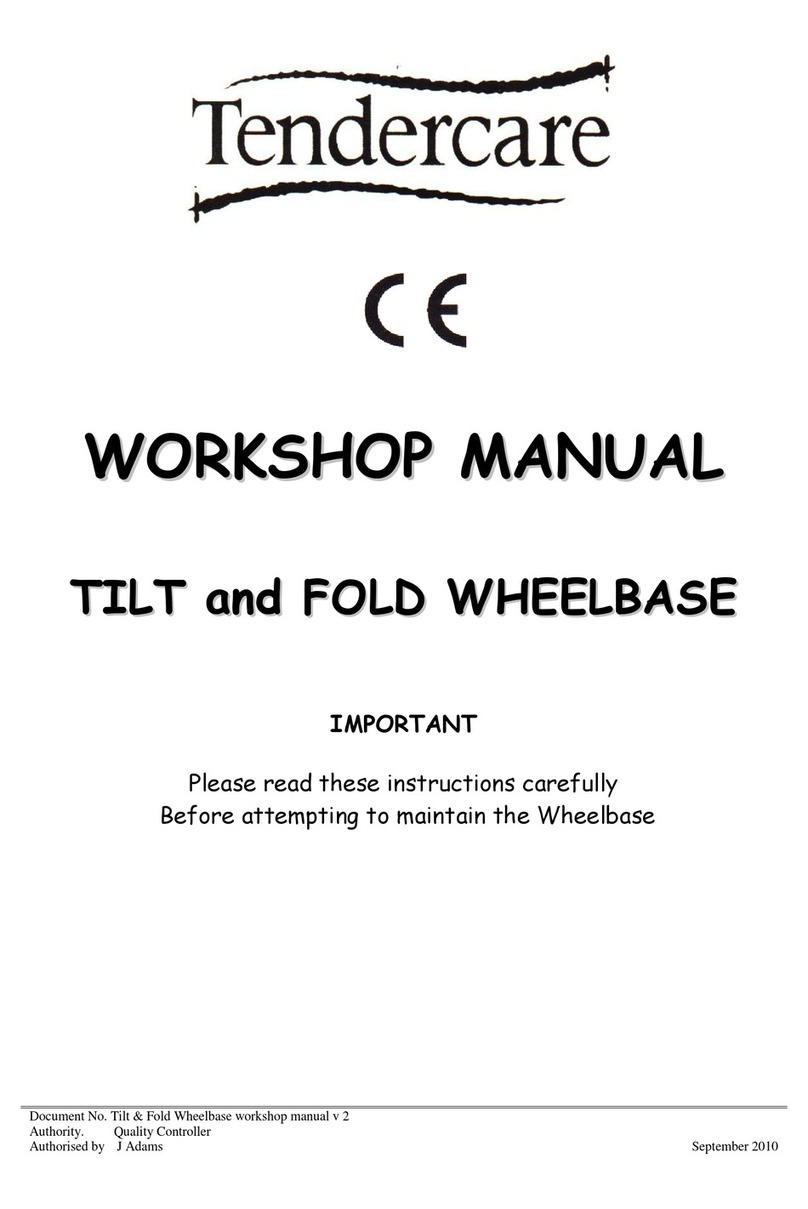
Tendercare
Tendercare TILT and FOLD Instruction manual
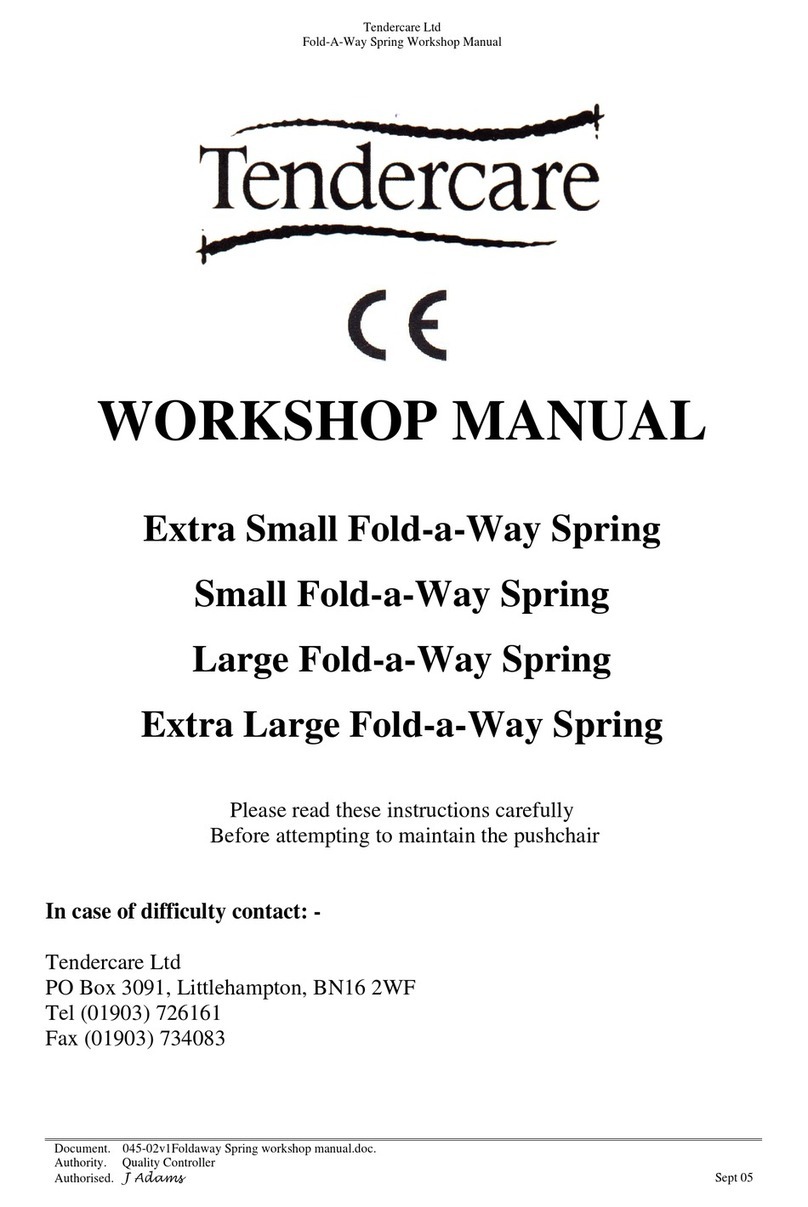
Tendercare
Tendercare Extra Small Fold-a-Way Spring Instruction manual

Tendercare
Tendercare Mini Tilt Wheelchair Instruction manual

Tendercare
Tendercare Gas Strut Model v4 User manual

Tendercare
Tendercare MINI TILT Instruction manual

Tendercare
Tendercare New Aluminium Mini Tilt Wheelchair User manual
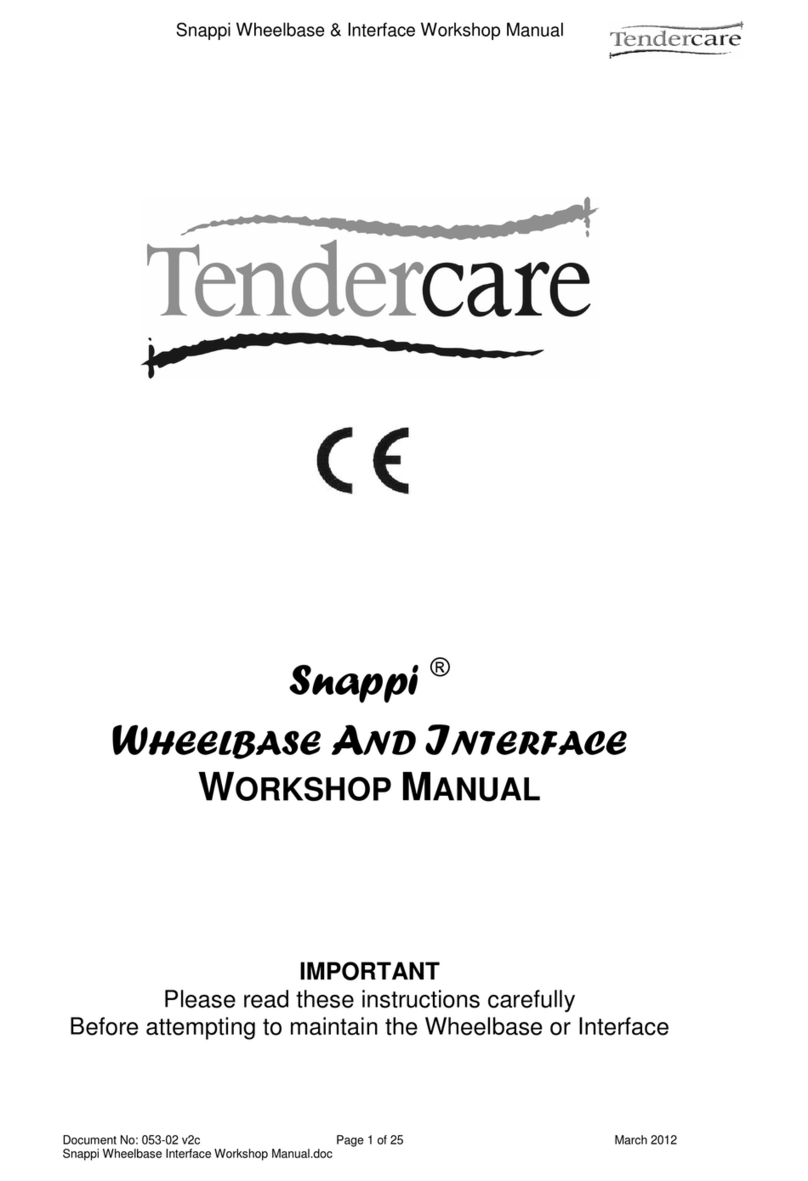
Tendercare
Tendercare Snappi Instruction manual
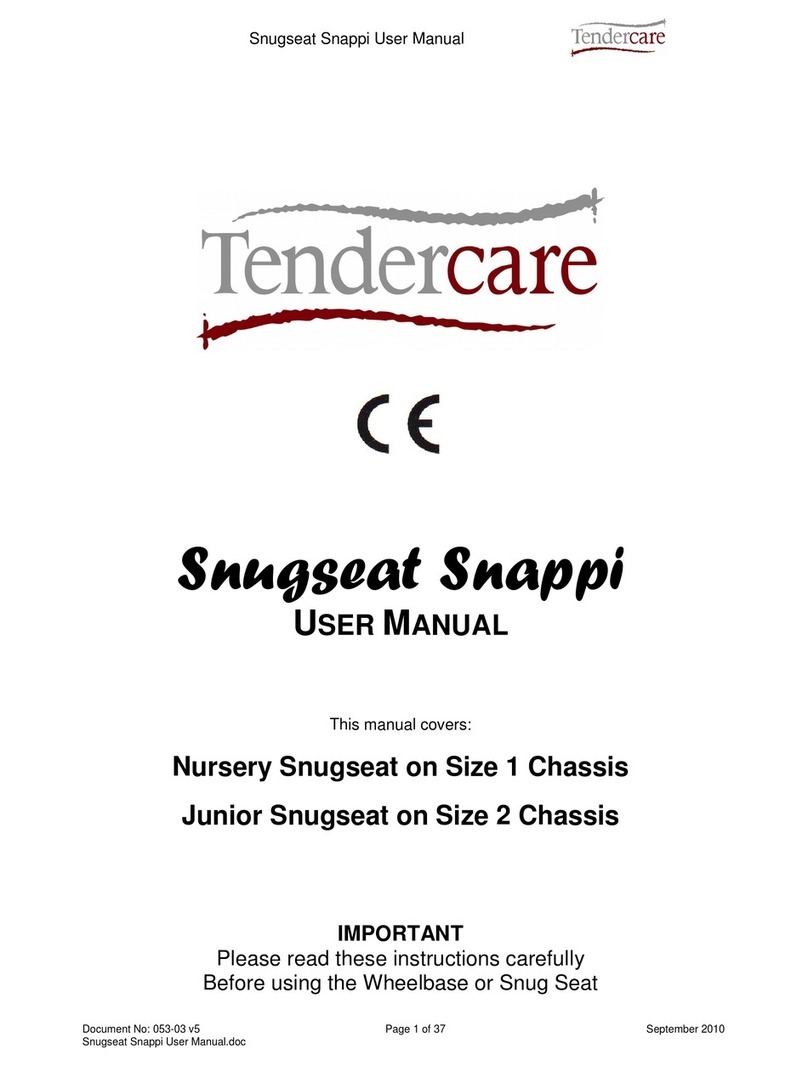
Tendercare
Tendercare Snugseat Snappi User manual

Tendercare
Tendercare Extra Small Fold-a-Way Spring User manual

Tendercare
Tendercare MINI TILT User manual
